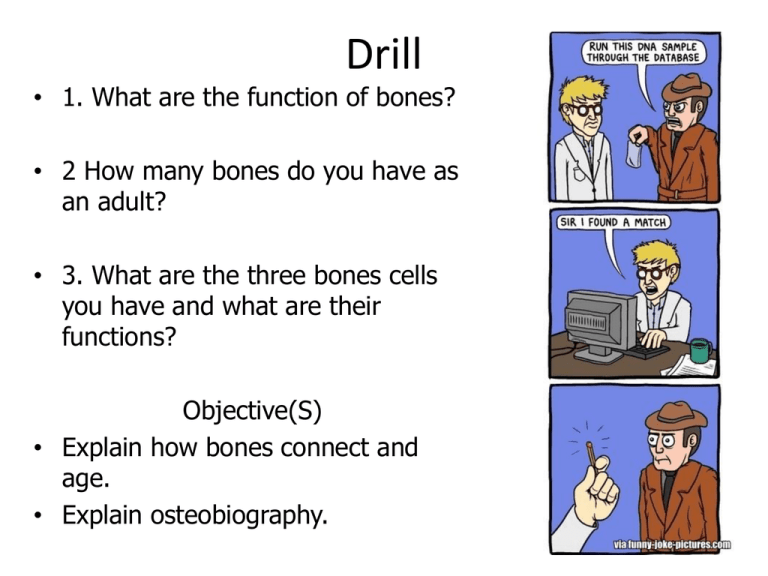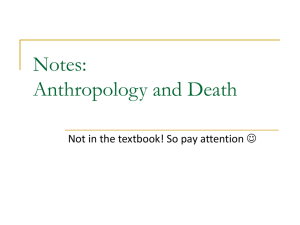
Drill
• 1. What are the function of bones?
• 2 How many bones do you have as
an adult?
• 3. What are the three bones cells
you have and what are their
functions?
Objective(S)
• Explain how bones connect and
age.
• Explain osteobiography.
Drill
• 1. Name & describe the 3
ways bones are held
together.
• 2. Define anthropology,
physical anthropology,
forensics anthropology.
Objective(s)
How bones determine
gender, age, height.
• 2. Define osteobiography.
• 3. Name 2 ways to determine if bones are
male or female.
Drill
• Name a function of bone.
• What can bones tell us about the person?
Chapter 13 Forensic Anthropology:
What We Learn from Bones
By the end of this chapter you will be able to:
• describe how bone is formed
• distinguish between male and female skeletal remains
• explain how bones contain a record of injuries and
disease
• describe how a person’s approximate age could be
determined
• discuss the role of mitochondrial DNA in bone
identification
All Rights Reserved South-Western / Cengage Learning © 2009
Forensic Science:
Fundamentals & Investigations,
Chapter 13
5
Historical Development
• _______________ – Scientific study of all
aspects of bone.
tools
language
traditions
____________________________ – studies
human differences
Historical Development
• ______________________________ – Studies
these identifying characteristics on the
remains of an individual.
•
•
•
•
Sex
Race
Height
Physical health
Historical Development
In the _________s, scientists began studying skulls.
This laid the framework for today’s knowledge.
2. In ________________ the _______opened the first
crime lab.
3. The _________________________ became its
working partner in the identification of human
remains.
4. Soldiers killed in _________________ were identified
using anthropologic techniques.
5.
__________________ in _________ found in the
___________of cells has been used in
Forensic
Science:
identification,
(Romanov case)
Fundamentals & Investigations,
8
1.
Chapter 13
Characteristics of Bone
• Bones are __________
• Function
– ___________________
– ___________________
– ___________________
– ___________________
Development of Bone
•
Bones originate from cells called
_____________, ________ type of bone cells.
•
They migrate to the center of _____________
production and _____________ – _________.
•
_____________ – _____ type of bone cell are
__________ trapped in new bone _________.
•
______________ life, bones are being
___________, __________, and ___________.
•
_____________, the ____ type of bone cell,
among other tasks, _______ _______ ______.
Forensic Science:
Fundamentals & Investigations,
Chapter 13
10
Review
• Are bones alive?
• Name two functions of bones.
• Name the three types of bone cells.
Number of Bones
• Baby – _____ bones
• Adult – _____ bones
– Bones ______ together.
How Bones Connect
•
Bones are held together by:
a. ___________ -wraps the ends of bones and
keeps them from scraping one another.
b. ___________—bands that connect two or
more bones together.
c. ___________—connect muscle to bone.
•
•
Until about ____ years of age, bones ________ in
_______.
___________ after ____ can be slowed with
exercise.
Forensic Science:
Fundamentals & Investigations,
Chapter 13
13
Bone Aging
• ___________ being __________ and _________.
• ________ are _______ than _______ therefore
bones increase in size until the age of 30.
• After _____ bones _________ in size and break
down faster than reproduce.
• __________________ – risk of breaking bone
because they lost calcium.
• Some individuals some vertebrate _________
and get the _________ appearance.
• Number of bones, their conditions, age health.
Review
• Name how bones connect to each other.
• At what age to bone remodeling slow down?
• What disease can you get if more bone is lost
than replaced?
What Bones Can Tell Us
•
•
•
•
_________________ tells much about a person
through the study of the skeleton.
The bones of a _______________, for example,
would be ____________ than the bones of the
_______________.
Forensic scientists realize that bones contain a
record of the physical life.
Analyzing bones can reveal clues to such things as
__________, _____, ___________, and _________.
16
Gender
•
•
•
•
Is the female skull smoother than the male’s? _____________
Which frontal bone is lower and sloping? _________________
Are the male’s eye orbits more circular? __________________
Which jaw is more square, with an angle that is closer to 90o? ______
17
Gender
•
•
One of the _________ methods of
determining the ________ of a skeleton is by
examining the _______.
The ________ of a woman’s pelvis can be
_________.
The sub pubic angle of the female pelvis is
________ than _______o; the male’s, ____.
18
Gender
• Femur (Thigh bone)
– Females – angle of
femur in relation to the
pelvis is ________.
– Males – Angle is
_________ and
_______.
Review
• Name two differences between a male and
female skull.
• How do the hips tell us if it is a female or
male?
Age
• Can be determine by:
– Looking at particular _____________.
– ____________ or ___________ of ____________.
– Bones reach ______ at __________ _____, so
looking for specific characteristics (sutures).
Age
•
•
•
By about age ____, the suture at the _______ of the
_______ will have _______.
By about age ______, the suture running across the
top of the skull, back to front, __________will have
________.
By about age _____, the suture running side to side
_________over the top of the skull, near the front,
will have __________. 22
Age
• During life, many of the 450 bones a
person has at birth grow together,
finally forming 206 bones.
• As the ________ between them is
replaced, an ________ line is _____.
• When the _______ is fully replaced,
the line is ______ longer _________.
• This information can be used to
_____________ a skeleton’s ______.
23
Review
• How can bones help us determine the age of a
person?
• What does cartilage present in the skeleton
tell us about the age of a person?
Height
• Just as age can be estimated by looking at the
bones of the arm and leg, so also can an
_______ of ______ be made.
• Often, the approximate height of a person can
be calculated from ______ of the ____
______ even if just ____ of those is _____.
• _____________ and ______ will need to be
taken into consideration in making the
estimate.
Forensic Science:
Fundamentals & Investigations,
Chapter 13
25
How to Estimate Height
• Femur (American Caucasian male)
2.32 X femur(cm) + 65.53 (cm) = height
Convert cm to inches (2.54 cm = 1 inch)
Ex.
2.32 X 50 (cm) + 65.53 = 181.53cm Height
181.53 cm / 2.54 = 71.47in
71.47 inches / 12 (inches in a ft) = 5.95
How to Estimate Height
• 3.36(humerus) + 71.48 = height +/- 4.43 cm
• Height/2.54 = height in inches
How to Distinguish Race
• Is ______ ________ because of ___________.
• ___________ have been _____________.
• Some distinguishing characteristics:
– Shape of eye _______.
– _________ or ________ of __________________.
– Nasal index (measurement)
– _____________________ (projection of the upper
jaw, maxilla beyond the lower jaw).
Facial Reconstruction
• Exact _______ and ______ of bones will vary
from person to person.
• Shape & Size of _______, tissues that lay on
top of them will as well.
Facial Reconstruction
• A face is formed by the skull with the muscles and
tissues on top of the skull.
• Theoretically, nonetheless, a face can be _______ from
just skeletal remains.
• _________________ are positioned at __________
locations on a skull, and _______ is contoured to follow
the height of the markers.
• Today, ____________ ___________ perform a similar
function.
• These computer programs also can ______ missing
persons and criminals.
Forensic Science:
Fundamentals & Investigations,
Chapter 13
31
DNA Evidence
•
Bone contains ______ _______ _____.
•
But it does contain ______________________.
•
This has _____ that is __________ only from the
___________.
•
Long after nuclear DNA has been _____ through
tissue __________, ______________ can be
obtained from bone.
•
Results can be _________ with
___________________ on the __________________
Forensic Science:
Fundamentalsof
& Investigations,
32 skeletal remains.
the
family
to
identify
Chapter 13
Skeletal Trauma Analysis
• Forensic anthropologists often determine if
______ to bones occurred ______ or after _____.
• Definite __________ exist between patterns on
bones made by _______ and the patterns _____
by the ___________ after __________.
• __________________, ________________,
______________, and ______ wounds all have
______________ __________________.
Forensic Science:
Fundamentals & Investigations,
Chapter 13
33
. . . . . . . . . . Summary . . . . . . . .
• Bones are live and carry on all life functions.
• The condition of bones can tell investigators
about a person’s health and nutrition during
life.
• Male and female skeletons differ in many
ways.
• The age of a person at death can be
estimated by analysis of a number of bones.
Forensic Science:
Fundamentals & Investigations,
Chapter 13
34








